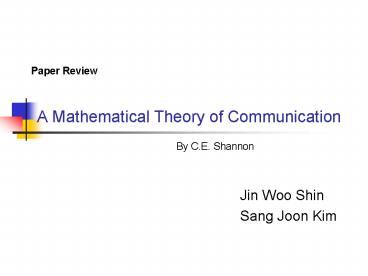A Mathematical Theory of Communication - PowerPoint PPT Presentation
Title:
A Mathematical Theory of Communication
Description:
A Mathematical Theory of Communication. Jin Woo Shin. Sang Joon Kim. Paper Review. By C.E. Shannon ... This paper opened the information theory. ... – PowerPoint PPT presentation
Number of Views:325
Avg rating:3.0/5.0
Title: A Mathematical Theory of Communication
1
A Mathematical Theory of Communication
Paper Review
By C.E. Shannon
- Jin Woo Shin
- Sang Joon Kim
2
Contents
- Introduction
- Summary of Paper
- Discussion
3
Introduction
- This paper opened the information theory.
- Before this paper, people believed the only way
to make the err. Prob. smaller is to reduce the
data rate. - This paper revealed that there is an achievable
positive data rate with negligible errors.
C.E. Shannon
4
Summary of Paper
- Preliminary
- Discrete Source Discrete Channel
- Discrete Source Cont. Channel
- Cont. Source Cont. Channel
5
Summary of PaperPreliminary
- Entropy
- Ergodic source
- Irreducible, aperiodic property
- Capacity
6
Summary of Paper Disc. Source Disc. Channel
- Capacity Theory (Theorem 11 at page 22)
- -The most important result of this paper
- If the discrete source entropy H is less than
or equal to the channel capacity C then there
exists a code that can be transmitted over the
channel with arbitrarily small amount of errors.
If HgtC then there is no method of encoding which
gives equivocation less than H-C.
7
Summary of Paper Disc. Source Cont. Channel
- Domain size of input and output channel becomes
infinity. - The capacity of a continuous channel is
- Tx rate does not exceed the channel capacity.
8
Summary of PaperCont. Source Cont. Channel
- Continuous source needs an infinite number of
binary digits for exact specification. - Fidelity the measurement of how much distortion
we allow - Rate with fidelity constraint D of Cont. source
P(X) is with - For given fidelity constraint D,
9
Discussion
- Ergodic source
- Practical approach
- Rate distortion
10
DiscussionErgodic source
- Ergodic Source assumption is the essential one in
the paper. - Source is ergodic -gt AEP holds -gt capacity
theorem - Finding a source that is not ergodic and holds
AEP is a meaningful work. - One example
11
DiscussionPractical approach -1
- This paper provides the upper bound of achievable
data rate. - Finding a good encoding scheme is another
problem. - Turbo code, LDPC code are most efficient codes.
- Block size, rate, BER, decoding complexity are
important factors when choosing a code for a
specific system.
12
DiscussionPractical approach -2
Year Rate ½ Code SNR Required for BER lt 10-5
1948 SHANNON 0dB
1967 (255,123) BCH 5.4dB
1977 Convolutional Code 4.5dB
1993 Iterative Turbo Code 0.7dB
2001 Iterative LDPC Code 0.0245dB
C. Berrou and A. Glavieux, "Near Optimum Error
Correcting Coding And Decoding Turbo-Codes,"
IEEE Trans. Comms., Vol.44, No.10, Oct 1996.
This graph and chart are modified from the
presentation data of Engling Yeo at Jan 15 2003
13
DiscussionRate distortion
- The Fidelity concept motives Rate Distortion
theory. - Rate with D distortion(fidelity) of Discrete
source P(x) is defined as
subject to - H(Entropy) is the rate with 0 distortion.
- (The Rate Distortion Theory) We can compress a
Disc. source P(x) up to ratio when
allowing D distortion.































